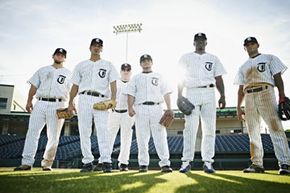Take me out to the ballgame, and I'll see pretty much the same thing whether I'm watching kids or professionals. Baseball teams have nine players. Each player takes turns at bat, and each plays a defensive position in the field. But who are they and what do they do?
The players are:
Advertisement
- Pitcher. Starts each play by pitching the ball from the pitcher's mound to the batter on the opposing team. The batter hits the ball, gets out after three strikes, or walks to first base after four balls (pitches ruled not in the strike zone). The pitcher fields hit balls that come into his area of the infield.
- Catcher. Positions himself, usually in a crouch, in the catcher's box behind home plate. Catches pitched balls that aren't hit and returns them to the pitcher. Catches hit balls when possible. Receives throws from fielders so he can put runners out at home plate, and throws from home plate to keep runners from stealing bases. He's the team's field leader, advising the pitcher on what pitches to throw.
The pitcher and the catcher are the only two players whose positions are clearly defined in baseball rules. At the start of each play, the pitcher must have one foot on the pitcher's plate (a rectangular piece of whitened rubber on the pitcher's mound) and the catcher must be in the catcher's box.
The other seven defensive players are divided into infield and outfield. Their positions on the team are determined by tradition and what works rather than rules.
The infield is the area enclosed by the base lines. The infield positions are:
- First baseman. Stands near first base, between first and second. Defends first base by catching balls hit near him and by catching throws from other fielders so he can put the runner out at first base.
- Second baseman. Stands near second base, between first and second. Defends second base by catching balls hit near it and receiving throws from other fielders. Is often key in double plays (getting two runners out) by receiving the ball from the shortstop, putting the advancing runner out at second and throwing to first to get the batter out there.
- Shortstop. Stands near second base, between second and third. Catches balls hit into that area. Covers second base when the second baseman is fielding the ball.
- Third baseman. Stands near third base, between second and third. Fields balls hit near the third base line. Catches balls thrown by other fielders to get runners out at third.
The outfield is the area beyond the infield. The left fielder, center fielder and right fielder spread out across the outfield and try to catch balls hit past the infielders. They also throw balls to the infielders to get runners out.
Now that we know the players, let's discuss their equipment on the next page.
Advertisement



